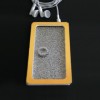Morphing and transforming objects as new interfaces
The assumption is that by changing their shape, digital artificats such as hand-held devices and computer peripherals can provide the user with a deeper understanding of their status. His thesis blog (see link below) is therefore called “shapeshifters”.
Orev developed several examples: A cube-shaped external hard drive indicates the level of synchronisation with the source computer by twisting itself, misaligning its shape.
A touch pad morphs in relation to the objects and applications being pointed at. It shows hidden qualities of an object — a big or small bump, for example, represents the size of a folder, while a rhythmic movement indicates the beat of an internet radio station.
There is even a TactoPhone (pictured) with an active 3D surface.
(This post is the fifth in a series of short features on the graduation projects by the final students of the Interaction Design Institute Ivrea, now located in Milan. As of next week, the Institute will be entirely absorbed within the Domus Academy‘s ‘I-Design” programme.)




